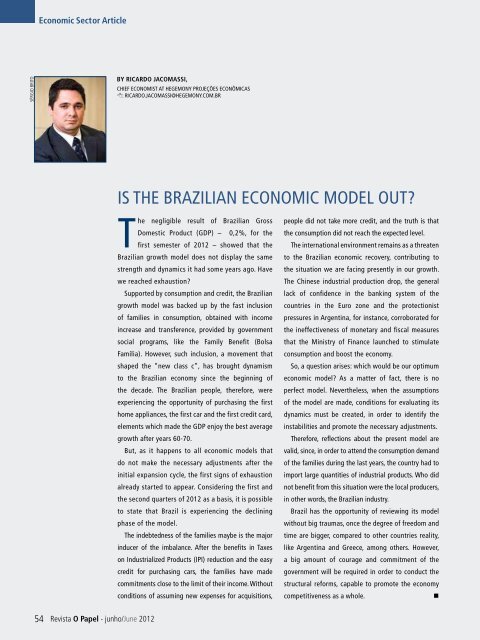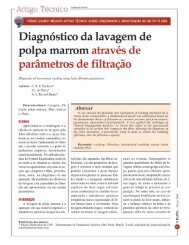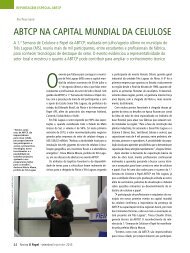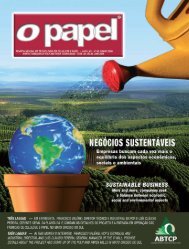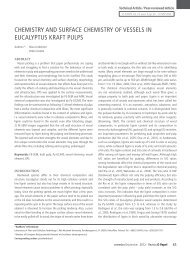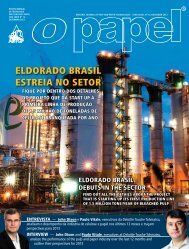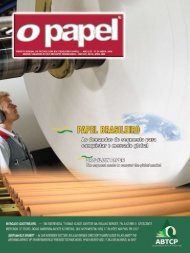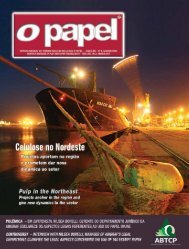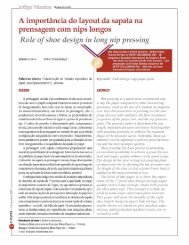INVISTA EM CONHECIMENTO - Revista O Papel
INVISTA EM CONHECIMENTO - Revista O Papel
INVISTA EM CONHECIMENTO - Revista O Papel
Create successful ePaper yourself
Turn your PDF publications into a flip-book with our unique Google optimized e-Paper software.
Economic Sector ArticleséRgio bRitoBY RicARdO JAcOmASSi,Chief eConomist at hegemony Projeções eConômiCas: riCardo.jaComassi@hegemony.Com.bris the brazilian eConomiC model out?the negligible result of brazilian grossdomestic Product (gdP) – 0,2%, for thefirst semester of 2012 – showed that thebrazilian growth model does not display the samestrength and dynamics it had some years ago. havewe reached exhaustion?supported by consumption and credit, the braziliangrowth model was backed up by the fast inclusionof families in consumption, obtained with incomeincrease and transference, provided by governmentsocial programs, like the family benefit (bolsafamília). however, such inclusion, a movement thatshaped the “new class c”, has brought dynamismto the brazilian economy since the beginning ofthe decade. the brazilian people, therefore, wereexperiencing the opportunity of purchasing the firsthome appliances, the first car and the first credit card,elements which made the gdP enjoy the best averagegrowth after years 60-70.but, as it happens to all economic models thatdo not make the necessary adjustments after theinitial expansion cycle, the first signs of exhaustionalready started to appear. Considering the first andthe second quarters of 2012 as a basis, it is possibleto state that brazil is experiencing the decliningphase of the model.the indebtedness of the families maybe is the majorinducer of the imbalance. after the benefits in taxeson industrialized Products (iPi) reduction and the easycredit for purchasing cars, the families have madecommitments close to the limit of their income. Withoutconditions of assuming new expenses for acquisitions,people did not take more credit, and the truth is thatthe consumption did not reach the expected level.the international environment remains as a threatento the brazilian economic recovery, contributing tothe situation we are facing presently in our growth.the Chinese industrial production drop, the generallack of confidence in the banking system of thecountries in the euro zone and the protectionistpressures in argentina, for instance, corroborated forthe ineffectiveness of monetary and fiscal measuresthat the ministry of finance launched to stimulateconsumption and boost the economy.so, a question arises: which would be our optimumeconomic model? as a matter of fact, there is noperfect model. nevertheless, when the assumptionsof the model are made, conditions for evaluating itsdynamics must be created, in order to identify theinstabilities and promote the necessary adjustments.therefore, reflections about the present model arevalid, since, in order to attend the consumption demandof the families during the last years, the country had toimport large quantities of industrial products. Who didnot benefit from this situation were the local producers,in other words, the brazilian industry.brazil has the opportunity of reviewing its modelwithout big traumas, once the degree of freedom andtime are bigger, compared to other countries reality,like argentina and greece, among others. however,a big amount of courage and commitment of thegovernment will be required in order to conduct thestructural reforms, capable to promote the economycompetitiveness as a whole.•54 <strong>Revista</strong> O <strong>Papel</strong> - junho/June 2012


